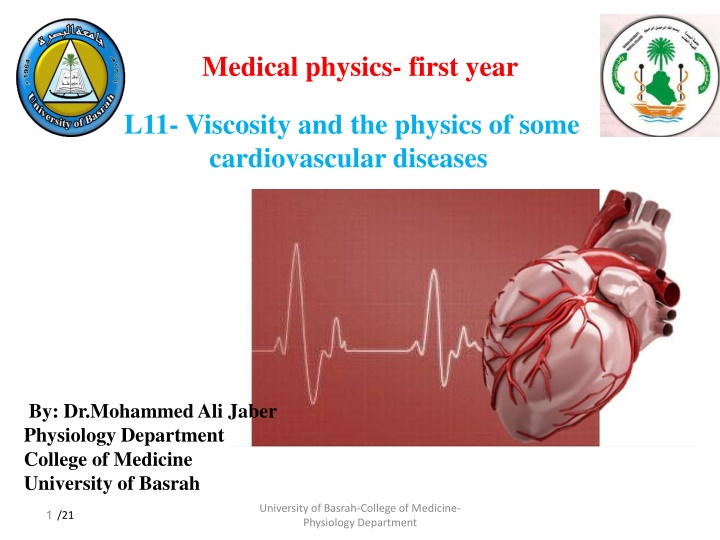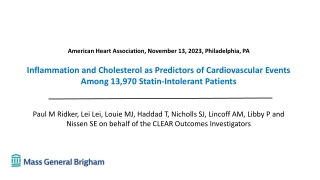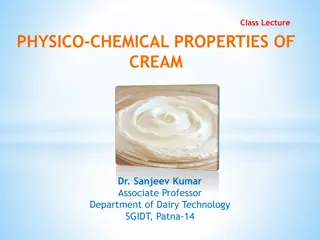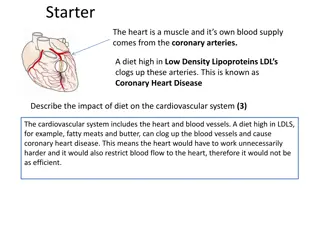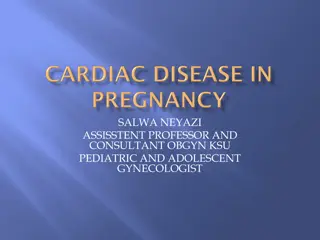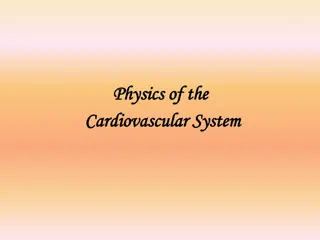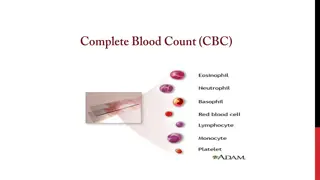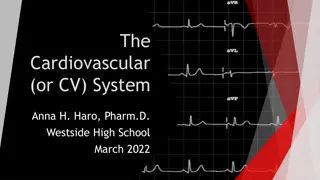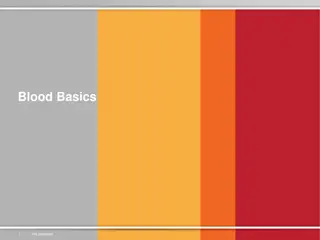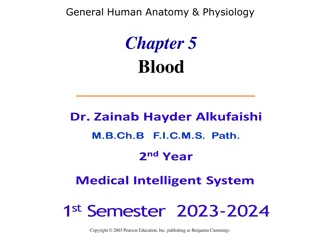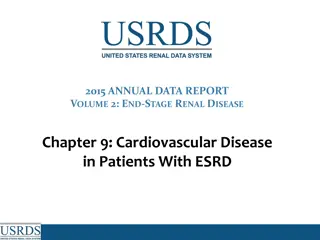Viscosity of Blood and Cardiovascular Impact
Understand the viscosity of blood and its significance in cardiovascular diseases. Explore the effects of factors like hematocrit and temperature on blood viscosity. Learn how changes in viscosity can affect organ perfusion and heart function.
Download Presentation

Please find below an Image/Link to download the presentation.
The content on the website is provided AS IS for your information and personal use only. It may not be sold, licensed, or shared on other websites without obtaining consent from the author.If you encounter any issues during the download, it is possible that the publisher has removed the file from their server.
You are allowed to download the files provided on this website for personal or commercial use, subject to the condition that they are used lawfully. All files are the property of their respective owners.
The content on the website is provided AS IS for your information and personal use only. It may not be sold, licensed, or shared on other websites without obtaining consent from the author.
E N D
Presentation Transcript
Medical physics- first year L11- Viscosity and the physics of some Medical physics- first year cardiovascular diseases By: Dr.MohammedAli Jaber Physiology Department College of Medicine University of Basrah University of Basrah-College of Medicine- Physiology Department 1 /21
Learning Objectives By the end of this lecture, you will be able to: Viscosity of blood Effects of Exercise on the Cardiovascular System The physics of some cardiovascular diseases University of Basrah-College of Medicine- Physiology Department 2 /21
Viscosity of blood Viscosity: is a property of fluid related to the internal friction of adjacent fluid and the wall of the vessel. The viscosity of plasma 1.8 viscosity of water at 37 (relative viscosity) It is related to the protein composition of the plasma Whole blood has a relative viscosity of 3-4 Viscosity depending on: Hematocrit , Temperature , Flow rate . University of Basrah-College of Medicine- Physiology Department 3 /21
1-Hematocrit : (the percentage of red blood cell in the blood) is an important factor effect in viscosity of blood . The relative viscosity at 0% hematocrit (plasma without cells) is about 1.8 As hematocrit increases, there is a disproportionate increase in viscosity. At a hematocrit of 40%, the relative viscosity is 4. At a hematocrit of 60%, the relative viscosity is 8. University of Basrah-College of Medicine- Physiology Department 4 /21
Therefore, a 50% increase in hematocrit from a normal value increase in blood viscosity by about 100% . Such changes in hematocrit and blood viscosity occur in a patients with polycythemia . Increased viscosity increases the resistance to blood flow and thereby increases the work of the heart and impairs organ perfusion. Some patients with anemia have low hematocrits, and therefore reduced blood viscosities. University of Basrah-College of Medicine- Physiology Department 5 /21
2- Temperature : there is an inverse relationship between temperature and viscosity. Viscosity increases about 2% for each degree centigrade decrease in temperature. Normally, blood temperature does not change much in the body. University of Basrah-College of Medicine- Physiology Department 6 /21
However, if a person's hand is exposed to a cold environment and the fingers become cold, the blood temperature in the fingers falls and viscosity increases. When whole-body hypothermia is induced in critical care or surgical situations, this leads to an increase in blood viscosity and impaired organ blood flow. University of Basrah-College of Medicine- Physiology Department 7
3-The Flow rate : At very low flow states in the microcirculation ,as occur during circulatory shock , the blood viscosity can increase . This occurs because at low flow states there are increased cell-to- cell and protein to cell adhesive interactions that cause erythrocytes to adhere to one another and increase the blood viscosity. University of Basrah-College of Medicine- Physiology Department 8 /21
Heart sounds The heart sounds heard with a stethoscope are caused by vibrations originating in the heart and the major vessels. The opening and closing of the heart valves contribute greatly to the heart sounds; turbulent flow occurs at these times and the vibrations produced are often in the audible range. University of Basrah-College of Medicine- Physiology Department 9
The amount and quality of the sound heard depend on : 1. The design of the stethoscope 2. The stethoscope pressure on the chest, 3. The stethoscope location, 4. The orientation of the body, 5. The phase of the breathing cycle. University of Basrah-College of Medicine- Physiology Department 10
Effects of Exercise on the Cardiovascular System (Short Term Effects of Exercise on the Cardiovascular System) Faster heart contractions : This leads to an increased heart rate and increased circulation, which gets oxygenated blood to your muscles quicker. heart at rest heart working hard University of Basrah-College of Medicine- Physiology Department 11 /21
Exercise uses up a lot of energy, which the cells derive from oxidizing glucose. Both glucose and oxygen have to be delivered by the blood. The heart has to work harder to pump more blood through the body. More forceful heart contractions with each heartbeat, which leads to a greater amount of blood being pumped throughout the body. Can be described by this equation: Blood Flow = heart rate stroke volume University of Basrah-College of Medicine- Physiology Department 12 /21
Heart rate for a human being at rest is about 70 beats/min. During vigorous exercise, heart rate can increase dramatically .This will result in an increase in blood flow. Long Term Effects of Exercise on the Cardiovascular System These effects include: The heart and lungs become more efficient as your cardiovascular training increases. Decreased resting heart rate, which means your heart doesn t have to beat as often to circulate blood. Improved ability to draw in deeper and longer breaths, and take fewer breaths. Reduced risk of heart disease. University of Basrah-College of Medicine- Physiology Department 13 /21
The physics of some cardiovascular diseases : Heart diseases often have physical component. Many of these diseases, for example, increase the work load of the heart or reduce its ability to work at a normal rate. W = P V equation of work done T = P R Laplace quation The work done by the heart is roughly the tension of the heart muscle times how long it acts. Anything that increase the work load of the heart. For example University of Basrah-College of Medicine- Physiology Department 14/21
1- Hypertension Causes the muscle tension to increase in proportion to the pressure, due to Laplace law T = PR so the high blood pressure causes to increase the work done by equation W = P V University of Basrah-College of Medicine- Physiology Department 15/21
2-Tachycardia A fast heart rate increases the work load since the amount of time the heart muscle spend contracting increases University of Basrah-College of Medicine- Physiology Department 16/21
3-Enlargement of the heart and reduction in the ability of the heart to provide adequate circulation. If the radius of the heart is doubled, the tension of the heart muscle must also be doubled if the same pressure is to maintained. Since the heart muscle is stretched , it may not be able to produce sufficient force to maintain normal circulation , the stretched heart muscle is also much less efficient than normal heart muscle. University of Basrah-College of Medicine- Physiology Department 17 /21
4. Heart valve defects, types of the Heart valve defects Stenosis: - Aortic valve stenosis or aortic stenosis occurs when the heart's aortic valve narrows. The valve does not open fully, which reduces or blocks blood flow from your heart into the main artery to your body (aorta) and to the rest of your body. The valve does not open wide enough. University of Basrah-College of Medicine- Physiology Department 18
In stenosis, the work of the heart increased because a large amount of work done against the obstruction of the narrow opening, and the blood supply to the general circulation reduced. University of Basrah-College of Medicine- Physiology Department 19
Insufficiency (Regurgitation): - Valvular insufficiency is a cardiac disease characterized by the failure of one or more of the heart valves to close perfectly resulting blood flowing backwards across the valve The valve does not close well enough. In insufficiency, some of the pumped blood flows back into the heart so that the volume of the circulated blood reduced. University of Basrah-College of Medicine- Physiology Department 20
University of Basrah-College of Medicine- Physiology Department 21
